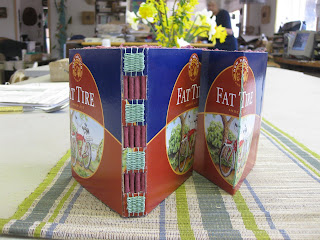In my experience with many aspects of fiber art, I usually get a grasp of many hand processes fairly quickly. Japanese papermaking was not one of those things.

Just looking at the difference in Claudia's demo sheet and my sheet, you can see the fibers are supposed to line up and distribute very evenly.
[My poor first attempt at Japanese papermaking]

[Claudia's demo-- note the difference.]
I made about twenty sheets of kozo paper (at least they looked like ok sheets to me) using a sugeta and then switched to western papermaking using the Thai kozo in the vat. I still have plenty of kozo (in my freezer) ready to make more sheets and I am determined to get a handle on this using the sugeta.

[Both kozo pages, on the left is japanese papermaking, right is made with a western mould and deckle.]






